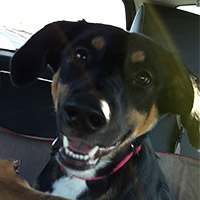Setting a mental state into motion before you actually need it to increase the probabilities of success and to realistically adjust your expectations
Priming is the idea of setting a mental state into motion before you actually need it. In this case, it involves training indoors for short, intense bursts to get your dog engaged and focused. I’ve noticed a distinct difference between the dog who is primed and the dog who isn’t. And of course, the more you do it, the better they’ll listen over time.
Training outside can be challenging because of all the distractions, but priming can give you a higher probability of success. It’s also much easier to train inside which means it’s low cost for a high benefit. I’ve had even greater success by priming outside around my building and THEN going for a walk. This involves strict training out the door, down the elevator, through the lobby, and in circles around the building. Once I feel we’ve reached a good point we depart to explore the city. I also usually restrict the first few social encounters as well. Think of it as a fading practice. You prime inside, then outside, then for the first five minutes of your walk allowing more freedom the longer you go. Use commands, keep them engaged by requiring eye contact, and setup boundaries that require them to walk politely alongside of you. The goal is to slowly expand outward and slowly diminish the rules until you have a well behaved dog.
The idea of priming came to me when I started to treat outdoor environments as a completely separate training area. Meaning that it has it’s own progress that’s disconnected from indoor success. Just because Ellie sits, stays, and comes inside, doesn’t mean she’ll succeed at the same level outside. This was a helpful perspective to adopt because it also required me to reset my expectations. Expecting Ellie’s indoor performance to match what happened outside was naive and unnecessarily increased frustration. The outdoor world is a fascinating place for a young puppy full of distractions and new challenges. Adapt accordingly.
Another helpful tactic during the first five minutes of walking is to use treats and count out eye contact. I do this by counting each glance up to 5, taking out a treat, and then counting to 10 before I reward her (read more here). I also tell her “no” when she tries to stop and tug gently on her leash to redirect her focus forward. The objective is to remain focused, keep walking, and give me eye contact for a sustained period of time. Anything outside of that is not allowed (besides potty breaks and greeting best friends of course).
Don’t expect these things to work right away though. It gives you an advantage, but requires time and effort to optimize. Be patient, accept failure, and keep trying. It WILL shape your dog over weeks and months, if you make it consistent. A simple hack to help improve performance is to show and hide treats in your pocket. There is a noticeable difference between Ellie with treats and Ellie without, but I can achieve similar results by showing her treats and then hiding them back in my pocket. I distribute just a few in the beginning and randomly along our walk to remind her that they exist. This increases the likelihood of good behavior and doesn’t require a treat bag or excessive rewarding.
Sometimes during these early training sessions you might feel bad restricting your dog or get looks from people when you avoid socialization. However, it’s ok to temporarily apply strict directives, not just in single sessions, but over a period of time as well. It can help lay a foundation for future good behavior and I’ve found that dog training relies not just on situational knowledge, but also an ability to predict future events. Priming and strict walks might seem overbearing at times, but look forward and see the potential for a positive walking experience that’s only 15 minutes away and the well-behaved, trustworthy dog that develops over the coming months.
Priming is a useful tool that helps shape your dog and boosts immediate results. It also helps readjust your expectations and reveals the differences between indoor and outdoor training. By testing out the recommendations above you can start to better understand your canine friend and realize the deliberate effort, the consistency, and the commitment required to achieve great results.
